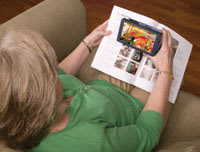FOCUS ON
LOW VISION
Senior
Class: Training
Tips
by Karlen McLean, ABOC, NCLC
|
|
|
Low vision devices help seniors see the world more clearly. Photo courtesy of Eschenbach Optik |
During low vision office visits and device dispensing, efficiency counts not only in the practice, but also with senior patients. The number of visits, cohesiveness of education, and additional services available can make or break a low vision practice.
Taking tips from veterans, EB has put together this primer to help you and your patients get the most for the investment.
CONVENIENCE
Convenience is a challenge for seniors with low vision who may be dependent on others for everyday tasks like driving and shopping. Getting from one place to another is often the biggest problem.
"The more transportation seniors have to do, the less successful
their low vision training might be, simply because transportation can be so
difficult
for this age group when combined with the challenge of low vision. We try to minimize
travel," says Judith E. Goldstein, OD, a practitioner with 11 locations in Maryland.
Successful training and use of a low vision device on the first or second visit is crucial. Seniors must understand that working to use these devices can help them gain independence and make their lives easier.
|
|
|
Low vision devices can make reading possible again. Image courtesy of Enhanced Vision |
"Seniors with low vision tend to get discouraged easily and are reluctant to pursue further service if they don't see some tangible result from their visit," mentions Paul Homer, MD, of Low Vision Solutions in Boca Raton, Fla. "Those who are looking for a magic pair of glasses are a setup for failure. Once they accept the principle that they were referred to us because their regular glasses don't work due to impaired vision, they do much better."
Adds Goldstein, "I try to prescribe only one device at the first visit to cut down on confusion. This helps them have to master only one thing at a time. I don't want to overwhelm them with technology."
COGNIZANCE
While making sure there are clear goals for the patient is key, pulling caregivers into the process is critical as well. "It's important to educate family members on eye health and why the patient's vision can't be restored, but it can be enhanced. This is an educational process for family members who may also be at risk as they age," says Beverly Heishman, ABOM, NCLC-AC, optical manager at Fava & Maria Eye Associates, a practice based in Lebanon, Pa.
|
stepping stones |
|
Organizing
a practical protocol for each step of senior low vision care helps keep your practice
and patients on track. First visit: conduct a low vision evaluation, prescribe a device and do initial training. Hone the patient's host of complaints to one chief complaint, and work on that. Select and train on the device that the patient will likely be the most successful with to help instill confidence. Second visit: See the patient again around two months out for additional device training and to address other low vision issues. If additional training and devices are required, schedule an occupational therapist to visit the patient's home. Beyond: Establish a routine based on patient ability; sharper patients may be able to move on to other tasks and device-use sooner. Change devices as necessary as low vision conditions progress. |
GETTING THERE
Office visit frequency is dependent on the patient's ability and the type of vision device. "Office visits are often covered by insurance, but devices are not. There are agencies available to help with the purchase of low vision devices," Goldstein notes.
"You have to be upfront with this. Above all, you must show these patients value within the first and second visits," she adds. "Value isn't only a product, it could be an occupational therapist being able to work with them at home."
COMPETENCE
While the doctor's initial evaluation and device Rx sets low vision patients in motion, it's often the follow-up care that drives success.
"During home visits, occupational therapists can address low vision health-related care, such as talking glucometers for diabetics, talking or large-size dispensers for medicine, and large timers for kitchen use," Homer says.
Heishman advises to never lose sight of the basics. "Be patient. Be positive. Relate to the patient on their level about using devices. Re-education is likely. For example, with high-add Rxs, patients often revert to trying to hold their reading material at regular reading distance while the focal length is much closer."
|
getting there |
|
Transportation
is often the biggest challenge for seniors with low vision. Providing the ways and
means for them to be seen goes a long way toward making your practice a success. 1. Providing transportation to your practice is crucial, be it a van or car service, hiring a driver, or using a cab. 2. If patients can't easily come to you, you can go to them. Most low vision devices and some equipment used are transportable. Consider utilizing a vehicle for mobile low vision care. 3. Another way to be ultra-available to patients is by opening multiple clinics in the area you want to cover. You could do this by partnering with other professionals to share rental space or working with vision-related clinics or hospitals. 4. Utilize the Internet. Many low vision practice Websites offer advice and links to information for patients and caregivers to help them understand low vision problems and solutions. Instructions for large print viewing are often included. |





